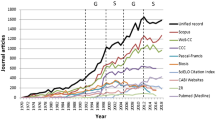Abstract
Gold Open Access (=Open Access publishing) is for many the preferred route to achieve unrestricted and immediate access to research output. However, true Gold Open Access journals are still outnumbered by traditional journals. Moreover availability of Gold OA journals differs from discipline to discipline and often leaves scientists concerned about the impact of these existent titles. This study identified the current set of Gold Open Access journals featuring a Journal Impact Factor (JIF) by means of Ulrichsweb, Directory of Open Access Journals and Journal Citation Reports (JCR). The results were analyzed regarding disciplines, countries, quartiles of the JIF distribution in JCR and publishers. Furthermore the temporal impact evolution was studied for a Top 50 titles list (according to JIF) by means of Journal Impact Factor, SJR and SNIP in the time interval 2000–2010. The identified top Gold Open Access journals proved to be well-established and their impact is generally increasing for all the analyzed indicators. The majority of JCR-indexed OA journals can be assigned to Life Sciences and Medicine. The success-rate for JCR inclusion differs from country to country and is often inversely proportional to the number of national OA journal titles. Compiling a list of JCR-indexed OA journals is a cumbersome task that can only be achieved with non-Thomson Reuters data sources. A corresponding automated feature to produce current lists “on the fly” would be desirable in JCR in order to conveniently track the impact evolution of Gold OA journals.









Similar content being viewed by others
Notes
Available: http://www.doaj.org [Accessed: August 08, 2012].
Appendix C: how many active, scholarly peer reviewed journals? Available: http://pages.cmns.sfu.ca/heather-morrison/appendix-c-how-many-active-scholarly-peer-reviewed-journals/ [Accessed: April 10, 2012].
The Thomson Reuters journal selection process. Available: http://thomsonreuters.com/products_services/science/free/essays/journal_selection_process/ [Accessed: October 29, 2012].
Pareto principle. Available: http://en.wikipedia.org/wiki/Pareto_principle [Accessed: October 29, 2012].
Bradford’s Law. Available: http://en.wikipedia.org/wiki/Bradford%27s_law [Accessed: October 29, 2012].
It is important to know that JCR refers to Q1 as the highest quartile including the category’s top 25 % journals, whereas Q1 in conventional descriptive statistics delimits the lower 25 % of the distribution.
In early August 2012 this number has risen to >8,000 titles.
References
Björk, B.-C., & Solomon, D. (2012). Open access versus subscription journals: a comparison of scientific impact. BMC Medicine, 10, 73. doi:10.1186/1741-7015-10-73.
Craig, I. D., Plume, A. M., McVeigh, M. E., Pringle, J., & Amin, M. (2007). Do open access articles have greater citation impact? A critical review of the literature. Journal of Informetrics, 1(3), 239–248. doi:10.1016/j.joi.2007.04.001.
Garfield, E. (1971). The mystery of the transposed journal lists—wherein Bradford’s Law of scattering is generalized. According to Garfield’s Law of concentration. Current Contents, 17, 222–223. In: Essays of an Information Scientist, 1, 1962–1973. http://www.garfield.library.upenn.edu/essays/V1p222y1962-73.pdf. Accessed 29 Oct 2012.
Giglia, E. (2010). The impact factor of open access journals: data and trends. ELPUB2010. Publishing in the networked world: transforming the nature of communication. In: T. Hedlund, Y. Tonta (eds) 14th International Conference on Electronic Publishing, 16–18 June 2010 (pp. 17–39) Helsinki. ISBN 978-952-232-086-5. http://hdl.handle.net/10227/599.
González-Pereira, B., Guerrero-Bote, V.P., & de Moya-Anegón, F. (2010). A new approach to the metric of journals’ scientific prestige: the SJR indicator. Journal of Informetrics, 4(3), 379–391. (http://arxiv.org/ftp/arxiv/papers/0912/0912.4141.pdf).
Guédon, J.-C. (2008). Mixing and matching the green and gold roads to open access: take 2. Serials Review, 34(1), 41–51. doi:10.116/j.serrev.2007.12.008.
Harnad, S., Brody, T., Vallieres, F., Carr, L., Hitchcock, S., Gingras, Y., et al. (2008). The access/impact problem and the green and gold roads to open access: an update. Serials Reviews, 34(1), 36–40. doi:10.1016/j.serrev.2007.12.005.
Jubb, M., Cook, J., Hulls, D., Jones, D., & Ware, M. (2011). Costs, risks, and benefits in improving access to journal articles. Learned Publishing, 24(4), 247–260. doi:10.1087/20110402.
McVeigh, M. E. (2004). Open access journals in the ISI citation databases: analysis of impact factors and citation patterns. A citation study from Thomson Scientific. http://ip-science.thomsonreuters.com/m/pdfs/openaccesscitations2.pdf. Accessed 21 August 2012.
Moed, H. F. (2010a). The source normalized impact per paper is a valid and sophisticated indicator of journal citation impact. Journal of the American Society for Information Science and Technology, 62(1), 211–213.
Moed, H. F. (2010b). Measuring contextual citation impact of scientific journals. Journal of Informetrics, 4(3), 265–277.
Oppenheim, C. (2008). Electronic scholarly publishing and open access. Journal of Information Science, 34(4), 577–590. doi:10.1177/0165551508092268.
Schmidt, B. (2007). On the “golden” path—alternative business model for open-access-primary publication. Zeitschrift für Bibliothekswesen und Bibliographie, 54(4–5), 177–182.
SCImago. (2007). SJR—SCImago Journal & Country Rank. Retrieved May 2011. http://www.scimagojr.com.
Sotudeh, H., & Horri, A. (2007). Tracking open access journals evolution: some considerations in open access data collection validation. Journal of the American Society for Information Science and Technology, 58(11), 1578–1585. doi:10.1002/asi.20639.
Suber, P. (2004). Open access overview: focusing on open access to peer-reviewed research articles and their preprints. http://www.earlham.edu/~peters/fos/overview.htm. Accessed 11 Apr 2012.
Swan, A. (2010). The open access citation advantage: studies and results to date. http://eprints.soton.ac.uk/268516/2/Citation_advantage_paper.pdf. Accessed 21 Aug 2012.
Testa, J., McVeigh, M. E. (2004). The impact of open access journals. A citation study from Thomson ISI. http://www.lib.uiowa.edu/scholarly/documents/ISI_impact-oa-journals.pdf. Accessed 29 Oct 2012.
Wagner, A.B. (2010). Open access citation advantage: an annotated bibliography. Issues in science and technology librarianship. doi:10.5062/F4Q81B0W. http://www.istl.org/10-winter/article2.html. Accessed 21 Aug 2012.
Zitt, M., & Small, H. (2008). Modifying the journal impact factor by fractional citation weighting: the audience factor. Journal of the American Society for Information Science and Technology, 59, 1856–1860.
Acknowledgments
The authors wish to thank Steve Reding and Ambros Wernisch for their support with data compilation.
Author information
Authors and Affiliations
Corresponding author
Rights and permissions
About this article
Cite this article
Gumpenberger, C., Ovalle-Perandones, MA. & Gorraiz, J. On the impact of Gold Open Access journals. Scientometrics 96, 221–238 (2013). https://doi.org/10.1007/s11192-012-0902-7
Received:
Published:
Issue Date:
DOI: https://doi.org/10.1007/s11192-012-0902-7




